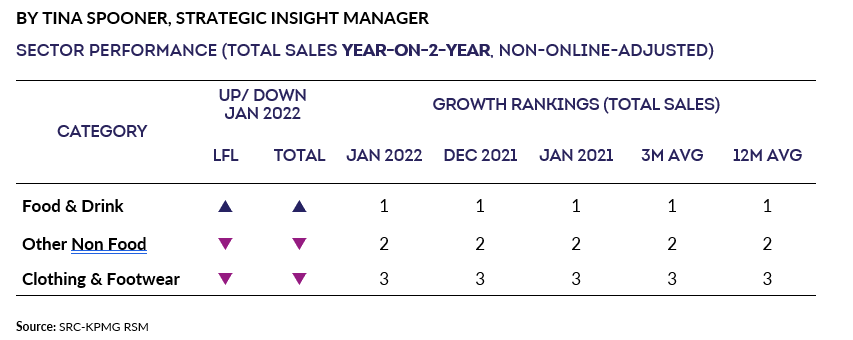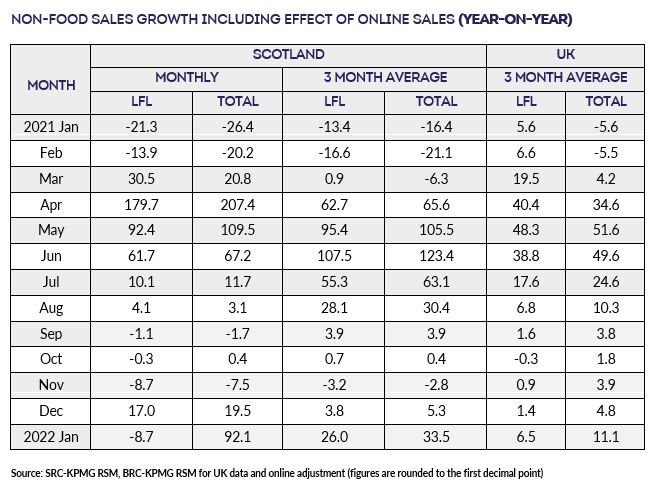During the pandemic much of retail bounced between being open and
closed, significantly impacting sales and changing consumer
behaviours. In January 2021, Scottish retail was in lockdown,
pushing many consumers to buy goods online. In this context, all
comparisons are provided on a year-on-2-year (Yo2Y) basis, we
have also included comparisons with January 2021 (YoY),
where relevant. This will be clearly signposted below.
Sales figures are not adjusted for inflation. Given that both the
January SPI (BRC) and December CPI (ONS) show inflation running
at historically high levels, a portion of the sales growth will
be a reflection of rising prices rather than increased
volumes.
Covering the four weeks 2 - 29 January
2022
- Total sales in Scotland decreased by 7.9% compared with
January 2020, when they had increased by 1.3%. This was above the
3m average decrease of 11.6% and the 12-month average
decrease of 10.8%.
-
The January performance is an improvement of 5.1 percentage
points from December 2021 and is the lowest Yo2Y decline
recorded since July last year.
- Scottish sales decreased by 3.0% on a Like-for-Like basis
compared with January 2020, when they had decreased by 0.1%. This
is above the 3-month average decrease of 10.1% and the 12-month
average decrease of 8.1%.
- Total Food sales increased 3.3% versus January 2020, when
they had increased by 2.7%. January was below the 3-month average
growth of 3.5% and the 12-month average growth of 4.3%. The
3-month average was below the UK level of 8.1%.
- Total Non-Food sales decreased by 17.3% in January compared
with the same month in 2020, when they had increased by 0.2%.
This was above the 3-month average decrease of 24.2% and the
12-month average decrease of 23.5%.
- Adjusted for the estimated effect of Online sales, Total
Non-Food sales decreased by 34.0% in January versus the same
month in 2020, when they had increased by 1.1%. This is above the
3-month average decline of 36.9% and below the 12-month average
decrease of 22.1%.
Ewan MacDonald-Russell, Head of Policy | Scottish Retail
Consortium
“January saw the best Scottish sales figures in six months as
shops kicked off 2022 with tentative signs of a recovery. Whilst
these figures are littered with caveats – the value of sales
remain nearly eight percent below pre-pandemic figures and are
bolstered by inflation – it’s nonetheless welcome to see an
improving performance after a dreadful end to 2021.
“Food sales fell back into negative territory compared to last
year, hardly surprising considering Scotland was locked down with
eateries shuttered, but were 3.3 percent up on 2020. However,
much of that growth derives from increased inflation which
grocers are now being forced to pass onto customers through
higher prices. Non-food sales were quite positive with
childrenswear, men’s smart clothing, and furniture all performing
well.
“It’s too early to tell if this is the start of a shopping
revival in Scotland, but these figures will provide a little
respite for a shattered retail industry. Nonetheless, there are
immense headwinds battering stores right now, with high
inflation, rising public policy costs, and stretched household
finances all making trading difficult. Hopefully there will be
brighter skies ahead, but it looks it will be sometime until we
arrive there.”
, Partner, UK Head of Retail |
KPMG
“An encouraging start to the year is welcome news, but with
inflation impacting both consumers and retailers, the months
ahead will require a balanced approach to drive growth. There are
clear signs we’re edging closer to traditional trading patterns
and sales falling back into line with pre-pandemic levels.
Normally a quiet trading month, January’s strong performance was
fuelled by non-food sales, with notable performers including
formal office wear, mirroring the return to the office for
many.
“It remains to be seen if sales will continue to grow and move
towards levels we saw before the pandemic. Scottish households
will be feeling the pinch in the months ahead, with rising energy
and fuel prices being compounded by inflation which is due to
peak in April. Retailers are facing their own inflationary
pressures and will need to take tough decisions on whether and
how to pass on the increased costs they have been sitting on for
some time to consumers facing their own financial challenges. We
could easily see the health of the sector start to deteriorate if
consumers choose to sit on savings to weather the storm.”



